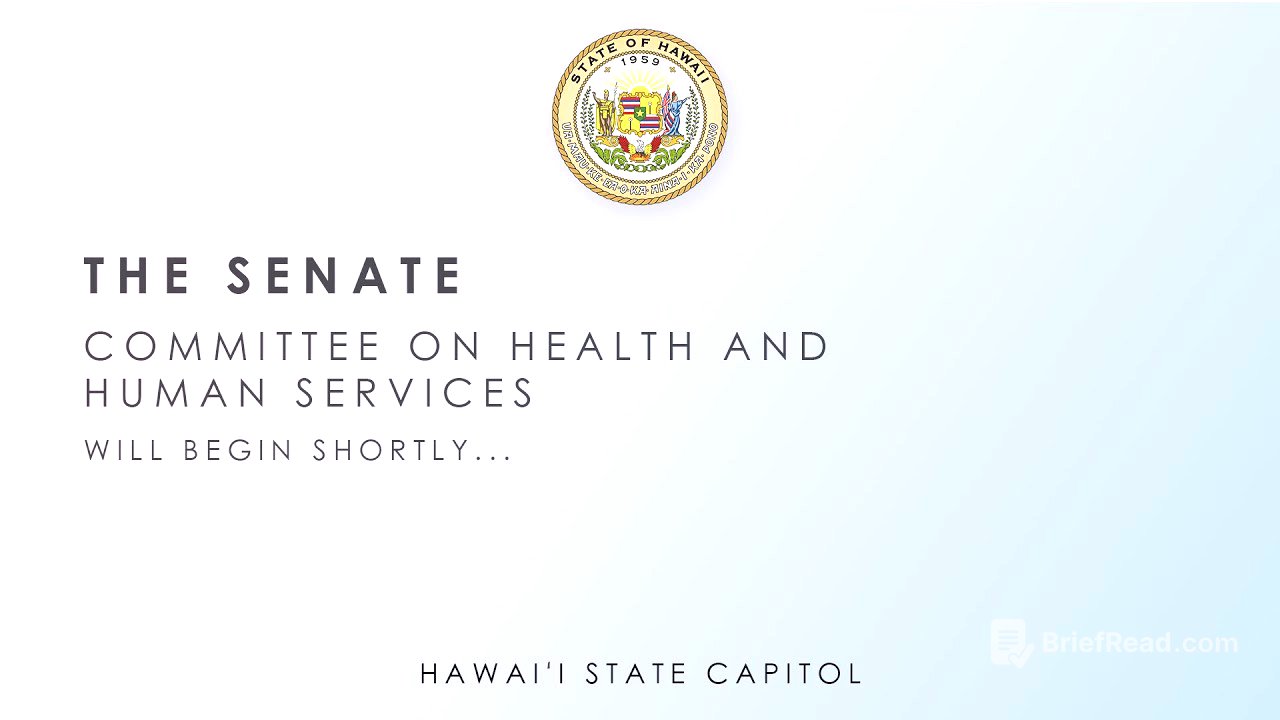TLDR;
This informational briefing by the Hawai'i State Senate focuses on the impacts of the federal government shutdown on state benefits, particularly health and human services. Key points covered include:
- The suspension of SNAP benefits due to the shutdown and its broad impact on households across Hawaii.
- The implementation of changes related to able-bodied adult work requirements and non-citizen eligibility for SNAP, occurring simultaneously with the shutdown.
- Efforts by the state government, including the establishment of the Hawaii Relief Program and collaboration with the Hawaii Food Bank, to mitigate the effects of the shutdown and address food insecurity.
- The role and current status of the WIC program in supporting women, infants, and children, and its ability to continue services through the end of the year.
- The increased demand on food banks and the challenges they face in providing food assistance during the shutdown, compounded by existing food insecurity issues in Hawaii.
Introduction to the Briefing [7:45]
The committee on health and human services is holding an informational briefing regarding the federal shutdown and its impacts on state health and human services benefits. The aim is to educate the public beyond short press releases about the governor's plans and the actual effects of the shutdown. The people involved have been working very hard and are stressed because the shutdown is lasting longer than expected.
Department of Human Services (DHS) Presentation on SNAP [9:53]
Scott Morish, the division administrator for the benefit employment and support services division at the Hawaii Department of Human Services, provides an overview of the division, which is the largest in DHS with nearly 700 staff positions in 19 offices. The division serves over 85,000 families or an estimated 166,000 individuals annually. SNAP, or the Supplemental Nutrition Assistance Program, is a federal program that provides monthly benefits to low-income households to help them purchase food. As of September, the program served 86,229 households, totaling 168,947 individuals, with an average benefit of about $346.83 per person per month. The monthly SNAP benefit is between $58 to $60 million and is 100% federally funded.
Impact of the Federal Shutdown on SNAP Benefits [13:27]
The USDA informed states that SNAP benefits would be suspended effective November 1st due to the federal shutdown that began on October 1st. DHS immediately issued a news release informing the public of the suspension and its impact. As of November 1st, November SNAP benefits will not be issued until the federal shutdown ends. Cash benefits for TANF, general assistance, or AABD will not be affected. SNAP participants can still use any remaining SNAP benefits on their EBT cards from October or prior months. DHS remains open to the public and will continue processing SNAP applications and re-certifications as normal.
Other Federal Impacts on SNAP [16:55]
The shutdown occurs in the context of other federal impacts on the SNAP program. On October 1st, there was an annual cost of living adjustment for SNAP, which in Hawaii meant a reduction due to a correction for overpaid benefits in federal fiscal year 2022. Effective November 1st, changes related to able-bodied adult work requirements and eligibility for non-citizens are being implemented.
Changes to Able-Bodied Adult Work Requirements [18:43]
The OOT tripleBA expands able-bodied adult work requirements to adults aged 55 to 64, adults in households with a dependent child aged 14 and older, people experiencing homelessness, veterans, and youth aged 18 to 24 transitioning from foster care. These requirements do not go into effect all at once; individuals will be assessed for compliance during their application or re-certification interviews. Activities to meet the work participation requirements include paid employment, participation in jobs programs, or volunteering.
Changes to SNAP Eligibility for Non-Citizens [21:25]
Effective November 1st, only lawful permanent residents, individuals present in the US based on the compact of free association (Kofa residents), and Cuban or Haitian entrants will be eligible for SNAP. All other categories of non-citizens that were previously eligible will now be considered ineligible. Ineligible non-citizens must still be reported as part of a household applying or during the household's re-certification, and their income will be counted in full towards a household's total income without any exclusion.
Summary of SNAP Impacts and Assistance Efforts [22:48]
Due to the shutdown and USDA directive, November SNAP benefits will not be issued if the federal government shutdown continues. When the shutdown ends, benefits would be paid to individuals at that time. Cash benefits will not be impacted, and SNAP benefits from prior months will still be accessible. The department is continuing to process applications and cases as normal. The department is working with the Hawaii Food Bank to identify $2 million in state funding and is standing up the Hawaii Relief Program, which will provide assistance primarily focused on housing for families with dependent children under 300% of the federal poverty level.
Discussion on Hawaii Relief Program and TANF Funds [26:59]
The administration is planning to use $100 million in temporary assistance for needy families (TANF) funding for the Hawaii relief program. These funds come from a TANF reserve, which is the balance of the grant not spent on benefits. The USDA's position is that using their SNAP contingency fee is not feasible because they don't consider this an emergency. The administration consulted with the administration for children and families and understands that using TANF funds is within acceptable uses as long as it aligns with the four primary purposes of TANF outlined in federal law.
Limitations and Mechanics of TANF and SNAP Funding [30:33]
The $100 million TANF reserve would only cover SNAP benefits for less than two months, as monthly SNAP benefits are around $60 million. The TANF money cannot be directly used to fill EBT cards due to specific mechanisms for SNAP distribution. The department is in conversations with the EBT vendor to explore different possibilities, but it's not a quick solution. The Hawaii relief program will make housing payments directly to the vendor, not to the participants.
State's Ability to Fund EBT Cards and TANF Implementation [32:36]
The state can potentially use state funding for EBT cards, but it involves complex mechanics with the eligibility system and funding sources. The announcement for the TANF release is anticipated later this week, with applications following. Legislation was previously passed to use TANF funds for housing subsidies, but it could not be implemented as originally envisioned due to federal agency clarifications. The Hawaii relief program is a nonrecurring program that can provide up to four months of payment for housing rent or mortgage, as well as for different utilities.
Concerns About Rainy Day Funds and TANF Eligibility [37:16]
There is disappointment that rainy day funds could not be used, despite setting aside more money last session. The reason for this is still under investigation. The TANF funds will only affect those individuals who are eligible for TANF, which is less than the 10% plus who are going to be affected by the shutdown. The governor is relying on the food bank because the rainy day funds cannot be used.
Governor's Considerations and Special Session [41:04]
Governor Green is fully aware of the issues and is coordinating efforts between various organizations to address the need. He is contemplating other mechanisms to ensure that the entirety of the population that needs food assistance will receive it. One of the funding sources could be the rainy day fund, which would require a special session to come into play. The policies in place require legislative authority to tap the rainy day fund.
Clarifications and Concerns Regarding Program Implementation [44:28]
It's critical to be clear and as simple as possible with the community about why things are being done the way they're being proposed. The community faced a similar situation during the 2018 lava flow when the governor had the ability to use $5 million without a special session. Over 10% of the people who qualify for SNAP will not qualify for TANF. There are concerns that people who may qualify for TANF will still be required to do the able-bodied work requirement when the shutdown ends.
Impact on TANF and WIC Programs [51:01]
TANF has not been impacted by the federal shutdown, only SNAP. Monies in the emergency budget reserve fund (EBRF) are not yet appropriated, and the Hawaii Constitution gives the legislature sole authority to appropriate funds, necessitating a special session to tap the EBRF.
Department of Health (DOH) Presentation on WIC [52:12]
Matt Shim, chief of the family health services division at the Department of Health, and Melanie Morakami, the WIC services branch chief, provide an update on WIC services during the federal government shutdown. WIC serves pregnant women, new mothers, infants, and children under age five who are at nutritional risk and meet income eligibility. In Hawaii, WIC serves approximately 26,000 participants per month statewide and operates 14 clinics across all counties.
WIC Funding and Services [54:50]
Every year in Hawaii, WIC food redemptions total about $30 million. The program has two types of funding lines: nutritional service and administration (NSA) funds and food funds. The federal food funds expire on November 10th, and the payroll and contracts NSA funds expire on December 15th. The Department of Health is reviewing all available funding to continue WIC services and food redemptions and has funds through December 31st.
Summary of WIC Operations and Future Planning [57:37]
WIC services are operating under normal conditions statewide through December 31st, 2025. People should continue to apply for benefits, receive their benefits, and re-certify for benefits through December 31st, 2025. The branch is continuing contingency planning to identify additional DOH resources for funds beyond January 1st if the government shutdown continues.
WIC Participant Demographics and SNAP Eligibility [59:00]
Half of the 26,000 WIC participants per month are children. If they qualify for SNAP, they're adjunctively eligible for WIC. The rate of SNAP eligibility among WIC participants is high, with at least half qualifying. The WIC program is enrolling people that are furoughed or not receiving any income. Participants who qualify for SNAP are not getting reduced benefits because they are assumed to be getting SNAP benefits.
WIC Funding and Potential Increase in Applicants [1:01:31]
The state has funded positions in WIC, and there are also federally funded positions. The federally funded staff have funds through December 15th, and the Department of Health funds will fund them through the end of December. The department is continuing to look to see what they would have available if the shutdown continues beyond January 1st.
Hawaii Food Bank Presentation [1:02:49]
Aaliyah Herman, the director of advocacy for Hawaii Food Bank, and Marielle Turbio, vice president of strategy and programs, discuss food security and the impact of the federal shutdown. Hawaii Food Bank serves Oahu and Kauaii and works closely with Maui Food Bank and the food basket on Hawaii Island. Food security is the lack of access to enough food for an active healthy life.
Food Insecurity Statistics and Hawaii Food Bank Services [1:05:19]
Statewide, one in three households in Hawaii are food insecure, with most having very low food security. Last year, Hawaii Food Bank worked with more than 275 partners to provide enough food for 19.7 million meals. Statewide, the food bank provided enough food for 29.1 million meals. For every dollar that the food bank receives, it is able to leverage it to over $5 worth of what you would buy at the store.
Local Farmer Investments and Federal Food Program Cuts [1:08:53]
The food bank invests in local farmers, with 77% of the produce purchase budget spent with local farmers and food hubs. Before the shutdown, food banks statewide had already lost over $4 million worth of food due to the end of a federal program. The amount of people being served is the same as the peak of the pandemic, but with less resources.
Impact of the Federal Shutdown on Food Insecurity [1:11:03]
The federal shutdown has two real impacts: increased demand due to layoffs and missed paychecks and disruptions to SNAP. Hawaii has the second highest number of federal civilian employees per capita and the highest concentration of military service members of all states. There are potentially 24,000 impacted civilian employees, 44,000 active duty service members, and an unknown amount of federal contractors, totaling 75,000 potential households at risk.
SNAP Benefits and Food Bank Capacity [1:13:23]
Hawaii food banks collectively connected families with food for over 2.4 million meals last year, while SNAP provides more than five times that statewide. This is an impossible gap for the food bank to close on its own. To prepare for increased need, the food bank placed orders for an additional 673,000 lbs of food, spending about $500,000.
Food Bank Distributions and Volunteer Opportunities [1:15:06]
The food bank is setting up additional distributions and expanding existing ones. There is a link for people to join an emergency volunteer squad. The pantry in Khi has added a distribution on Mondays for federally impacted families. The food bank is also working on setting additional popup distributions at key federal work locations.
Magnitude of SNAP Benefits and Food Bank Capacity [1:17:31]
The $2 million in state funding will help, but it's a huge gap to fill. It's not just the cost of food, but also the warehouse capacity, staffing, and trucks. Donating money makes the biggest difference because the food bank can stretch that dollar five times. 15% of the population is already potentially food insecure because of the federal shutdown.
Economic Impact and Food Sourcing [1:26:07]
The $8 per person SNAP decrease starting October 1st ends up being over a million dollars a month. The emergency food assistance program was responsible for really good, healthy, reliable food, and it was eliminated, resulting in $4 million less coming in statewide. The 2.4 million meals provided by the food bank versus the 13 million provided by SNAP highlights the economic impact of SNAP. The food bank gets its food from a range of places, including relationships on the continent, local farmers, and donations.
TANF Eligibility and Program Implementation [1:29:26]
About a third of SNAP recipients are families with children, meaning 2/3 won't be able to get any benefit from the TANF rental subsidy relief program. The school lunch programs are continuing and are not affected by the shutdown. The Department of Attorney General is looking at joining litigation with other states against the US Department of Agriculture to look at the issue of whether the contingency funds could be utilized.
Communication and Program Implementation [1:33:14]
It's important to get the message out to people who don't watch the news or read the paper. Every state website will have a banner that links to all of the resources available for people who are experiencing food insecurity. The Medicaid funds are not touched by the shutdown and could be implemented to feed people. Communication is key, especially for this population who don't have access.
Closing Remarks and Adjournment [1:34:40]
The committee thanks everyone who presented and acknowledges the stressors they are under as providers. The governor needs to communicate the need for a special session to legislators as soon as possible because getting quorum during the interim is very difficult. Feeding people should be top of mind. The fact that the state may not get fully reimbursed for the monies that are used up shouldn't be an obstacle. The committee is adjourned.









